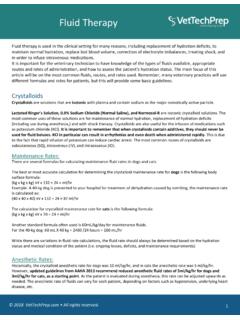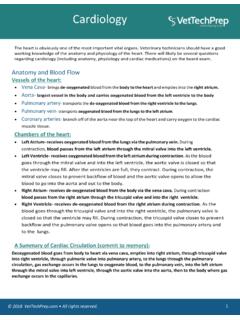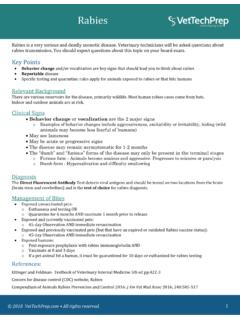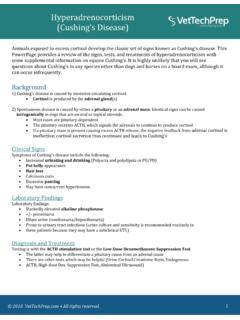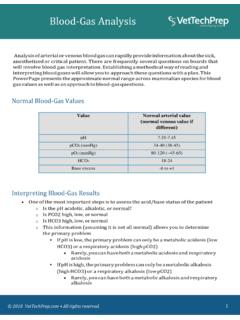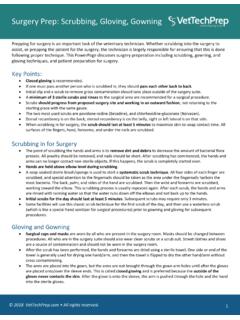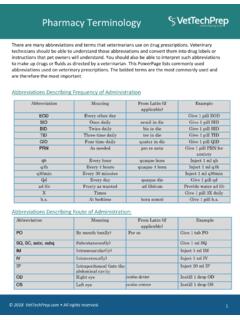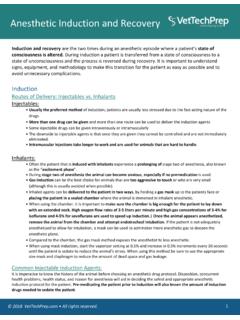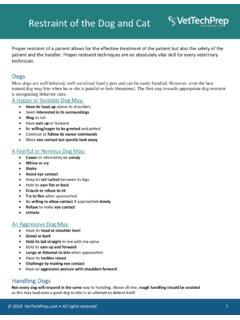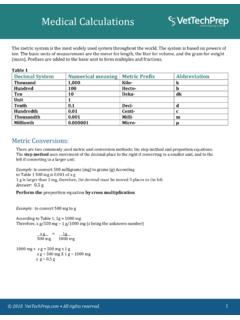Transcription of Pharmacology: Commonly Used Drugs - VetTechPrep
1 pharmacology : Commonly used Drugs The board exam places a big emphasis on pharmacology . The following PowerPage lists Commonly used Drugs in veterinary medicine with their classification and important information related to the Drugs . Most Drugs in a certain class will end in the same or similar suffix which can be helpful on boards if you see a drug with which you are not familiar. (Controlled substances*) Antibiotics: Gentamicin-aminoglycoside, can be renal-toxic Clindamycin- lincosamide Amoxicillin- aminopenicillin Enrofloxacin- fluoroquinolone (-oxacin suffix), may cause cartilage defects in young dogs, or blindness incats Cephalexin- 1st generation cephalosporin (oral) Cefpodoxime- 3rd generation cephalosporin (oral) Cefazolin- 1st generation cephalosporin (injectable) Cefovecin (Convenia)-3rd generation cephalosporin (injectable) Trimethoprim- sulfa (TMS)
2 - sulfonamide, may cause dry-eye Doxycycline- tetracycline antibiotic (Doxy doesn t typically cause bone and teeth abnormalities ordiscoloration in young animals but tetracyclines in general may cause this side effect). Should not be given asa dry pill to cats, as esophageal strictures may occur. Metronidazole- used Commonly to treat diarrhea or colitis, can rarely cause a neurotoxicity whichtreatment for is diazepam. May be used to treat : Prednisone Prednisolone Triamcinolone (Vetalog/Kenalog)- 4-10X more potent than hydrocortisone MethylprednisoloneAnalgesics:Opioids: are mu agonists or partial mu agonists, reversed with naloxone Fentanyl*- injectable or comes in a patch Morphine* Hydromorphone* Buprenorphine*-injectable can also be used orally, absorbs through oral mucosa Butorphanol*- injectable or tablets (tablets used as antitussive) Tramadol* (Ultram)- tablets- synthetic mu-receptor opiate agonistNon-Steroidal Anti-Inflammatories.
3 All NSAIDS cause increased risk of GI ulceration and may have effects on the liver and kidneys, labwork should be monitored Carprofen (Rimadyl)-COX-2 inhibitor; rarely may cause liver failure, most Commonly used post-operativelyfor analgesia and for arthritis management or acute orthopedic injury Meloxicam (Metacam)- may enhance risk of nephrotoxicity, mostly COX-2 inhibitor 2018 All rights reserved. 1 pharmacology : Commonly used Drugs Ketoprofen (Ketofen)- used most frequently as a fever reducer Firocoxib (Previcox)- COX-2 inhibitor Deracoxib (Deramaxx)- COX-2 inhibitor (may have some COX-1 effects at higher doses) Flunixin Meglumine (Banamine)- used mostly in horses Phenylbutazone ( Bute )- used mostly in horsesAnesthetics/Tranquilizers: Injectables.
4 Ketamine*- dissociative anesthetic, causes muscle rigidity ( used with diazepam because of this) Tiletamine*- dissociative anesthetic, part of Telazol (along with zolazepam) Valium* -benzodiazepine (end in the suffix pam), causes skeletal muscle relaxation and sedation byenhancing GABA Propofol- short acting hypnotic agent/injectable anesthetic, given slowly, may cause apnea andhypotension, white opaque in color Lidocane/Bupivicaine (local anesthetics, Lidocaine also given as anti-arrhythmic) Dexmedetomidine (Dexdomitor)- alpha-2 adrenergic agonist, reversed with atipamezole (Antesedan-analpha-2 adrenergic antagonist), should not be used in pets with cardiac disease or that are debilitated Xylazine- alpha-2 adrenergic agonist, reversed with yohimbine-an alpha-2 adrenergic antagonist) Acepromazine- phenothiazine tranquilizer, may lower seizure threshold (this is controversial but could beasked on boards) Apomorphine*- used to cause vomiting (emetic), injectable or comes in a tablet which can be placed in theconjunctival sac in the eye, opioid Thiopental- short acting thiobarbiturate, not recommended for greyhounds or other sighthounds due to slowmetabolism of this drugInhalants.
5 Most common side effect of inhalants is hypotension Isoflurane Sevoflurane Halothane (not widely used due to side effects, especially cardiac)Cardiac/Blood Pressure Furosemide (Lasix)- Loop diuretic most often used in congestive heart failure Enalapril/Benazapril- ace-inhibitors (end in suffix pril), used in treating heart failure and hypertension,sometimes used in chronic renal failure, causes vasodilation Pimobendan (Vetmedin)- inodilator, used in treating congestive heart failure Spironolactone (potassium sparing diuretic) Amlodipine (decreases blood pressure, choice anti-hypertensive for cats) Atropine- anticholinergic, used to increase heart rate; used in CPCR and also during anesthesia to treatbradycardia 2018 All rights reserved.
6 2 POWERPAGE TITLE - BOLD (22 pt) VERTICALLY CENTERED z 2017 All rights reserved. 1 pharmacology : Commonly used Drugs Anti-Parasitics: Fenbendazole (Panacur)- general anthelmentic, also Commonly used to treat Giardia Sulfadimethoxine (Albon)- treats coccidia Pyrantel- used primarily for ascarids Emodepside and Praziquantel (Profender)- topical dewormer for felines (Praziquantel is the treatment fortapeworms) Praziquantel, Pyrantel, and Febantel (Drontal plus) dewormer for canine or feline Selamectin (Revolution)- topical parasite prevention (ear mite tx, flea control, hooks, rounds, heartwormprevention), treatment for Sarcoptes Ivermectin (Heartgard or injectable)
7 - heartworm prevention, hooks, rounds, demodex treatment withinjectable, contraindicated in Collie type breeds Milbemycin (Interceptor)- (dogs or cats) heartworm prevention, hooks, rounds, whipsGastrointestinal: Famotidine (Pepcid AC)- H2 receptor blocker Carafate (Sucralfate)- gastroprotectant, also known as a band-aid for the GI tract, may impair absorption of some oral medications Metoclopramide (Reglan)- upper GI pro-kinetic agent, may cause excitement or hyperactivity in cats, anti-emetic- prevents nausea by blocking dopamine in the chemo-receptor trigger zone (CRTZ) Maropitant (Cerenia)- anti-nausea/anti-vomiting agent Cisapride- pro-motility agent for upper and lower GI, used in cats with megacolon (not commercially available, must get compounded) Omeperazole (Prilosec)
8 - proton pump inhibitor, used for treating and preventing GI ulcers Misoprostol- prostaglandin E1 analog, used to prevent gastric ulcerationOther Miscellaneous Drugs : Methocarbamol (Robaxin)- muscle relaxant Fluconazole/ketoconazole/itraconazole- anti-fungals, potentially hepatotoxic Trilostane (Vetoryl)- adrenal steroid synthesis inhibitor, used in treating hyperadrenocorticism Levothyroxine- thyroid hormone, treats hypothyroidism Methimazole (Tapazole)- inhibits synthesis of thyroid hormone, treatment for hyperthyroidism Diphenhydramine (Benadryl)- anti-histamine, used for allergies and allergic reactions Epinephrine- alpha and beta- adrenergic agonist, used mostly in anaphylaxis and cardiac resuscitation Guafenisen- muscle relaxant/ oral expectorant used primarily in large animal anesthesia for the musclerelaxation Pentobarbital* (Beuthanasia, Fatal Plus, others)- barbiturate, mostly used for euthanasia in vet med Phenobarbital*- barbiturate, anti-seizure medication Mirtazapine- tetracyclic antidepressant/ 5-HT3 antagonist- used as appetite stimulant in dogs and catsReferences 1)Plumb, Donald C.
9 Plumb s Veterinary drug Handbook. 6th edition. Blackwell Publishing. )Bill, Robert L. Clinical pharmacology and Therapeutics for the Veterinary Technician. Mosby. 2006. 2018 All rights reserved. 3
